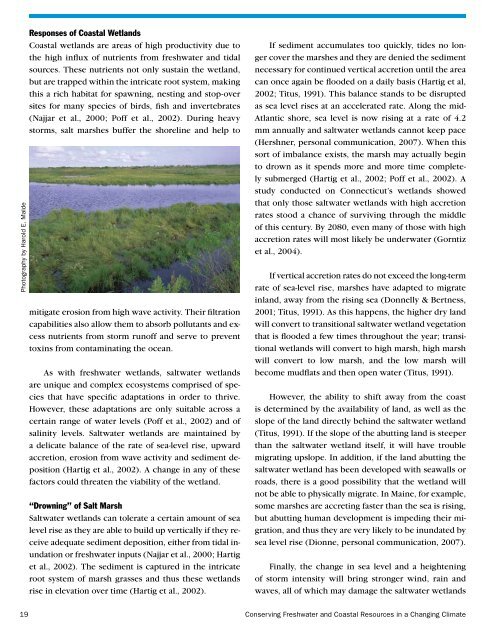Conserving Freshwater and Coastal Resources in a Changing Climate
Conserving Freshwater and Coastal Resources in a Changing Climate
Conserving Freshwater and Coastal Resources in a Changing Climate
You also want an ePaper? Increase the reach of your titles
YUMPU automatically turns print PDFs into web optimized ePapers that Google loves.
Photography by Harold E. Malde<br />
Responses of <strong>Coastal</strong> Wetl<strong>and</strong>s<br />
<strong>Coastal</strong> wetl<strong>and</strong>s are areas of high productivity due to<br />
the high <strong>in</strong>flux of nutrients from freshwater <strong>and</strong> tidal<br />
sources. These nutrients not only susta<strong>in</strong> the wetl<strong>and</strong>,<br />
but are trapped with<strong>in</strong> the <strong>in</strong>tricate root system, mak<strong>in</strong>g<br />
this a rich habitat for spawn<strong>in</strong>g, nest<strong>in</strong>g <strong>and</strong> stop-over<br />
sites for many species of birds, fish <strong>and</strong> <strong>in</strong>vertebrates<br />
(Najjar et al., 2000; Poff et al., 2002). Dur<strong>in</strong>g heavy<br />
storms, salt marshes buffer the shorel<strong>in</strong>e <strong>and</strong> help to<br />
mitigate erosion from high wave activity. Their filtration<br />
capabilities also allow them to absorb pollutants <strong>and</strong> excess<br />
nutrients from storm runoff <strong>and</strong> serve to prevent<br />
tox<strong>in</strong>s from contam<strong>in</strong>at<strong>in</strong>g the ocean.<br />
As with freshwater wetl<strong>and</strong>s, saltwater wetl<strong>and</strong>s<br />
are unique <strong>and</strong> complex ecosystems comprised of species<br />
that have specific adaptations <strong>in</strong> order to thrive.<br />
However, these adaptations are only suitable across a<br />
certa<strong>in</strong> range of water levels (Poff et al., 2002) <strong>and</strong> of<br />
sal<strong>in</strong>ity levels. Saltwater wetl<strong>and</strong>s are ma<strong>in</strong>ta<strong>in</strong>ed by<br />
a delicate balance of the rate of sea-level rise, upward<br />
accretion, erosion from wave activity <strong>and</strong> sediment deposition<br />
(Hartig et al., 2002). A change <strong>in</strong> any of these<br />
factors could threaten the viability of the wetl<strong>and</strong>.<br />
“Drown<strong>in</strong>g” of Salt Marsh<br />
Saltwater wetl<strong>and</strong>s can tolerate a certa<strong>in</strong> amount of sea<br />
level rise as they are able to build up vertically if they receive<br />
adequate sediment deposition, either from tidal <strong>in</strong>undation<br />
or freshwater <strong>in</strong>puts (Najjar et al., 2000; Hartig<br />
et al., 2002). The sediment is captured <strong>in</strong> the <strong>in</strong>tricate<br />
root system of marsh grasses <strong>and</strong> thus these wetl<strong>and</strong>s<br />
rise <strong>in</strong> elevation over time (Hartig et al., 2002).<br />
If sediment accumulates too quickly, tides no longer<br />
cover the marshes <strong>and</strong> they are denied the sediment<br />
necessary for cont<strong>in</strong>ued vertical accretion until the area<br />
can once aga<strong>in</strong> be flooded on a daily basis (Hartig et al,<br />
2002; Titus, 1991). This balance st<strong>and</strong>s to be disrupted<br />
as sea level rises at an accelerated rate. Along the mid-<br />
Atlantic shore, sea level is now ris<strong>in</strong>g at a rate of 4.2<br />
mm annually <strong>and</strong> saltwater wetl<strong>and</strong>s cannot keep pace<br />
(Hershner, personal communication, 2007). When this<br />
sort of imbalance exists, the marsh may actually beg<strong>in</strong><br />
to drown as it spends more <strong>and</strong> more time completely<br />
submerged (Hartig et al., 2002; Poff et al., 2002). A<br />
study conducted on Connecticut’s wetl<strong>and</strong>s showed<br />
that only those saltwater wetl<strong>and</strong>s with high accretion<br />
rates stood a chance of surviv<strong>in</strong>g through the middle<br />
of this century. By 2080, even many of those with high<br />
accretion rates will most likely be underwater (Gorntiz<br />
et al., 2004).<br />
If vertical accretion rates do not exceed the long-term<br />
rate of sea-level rise, marshes have adapted to migrate<br />
<strong>in</strong>l<strong>and</strong>, away from the ris<strong>in</strong>g sea (Donnelly & Bertness,<br />
2001; Titus, 1991). As this happens, the higher dry l<strong>and</strong><br />
will convert to transitional saltwater wetl<strong>and</strong> vegetation<br />
that is flooded a few times throughout the year; transitional<br />
wetl<strong>and</strong>s will convert to high marsh, high marsh<br />
will convert to low marsh, <strong>and</strong> the low marsh will<br />
become mudflats <strong>and</strong> then open water (Titus, 1991).<br />
However, the ability to shift away from the coast<br />
is determ<strong>in</strong>ed by the availability of l<strong>and</strong>, as well as the<br />
slope of the l<strong>and</strong> directly beh<strong>in</strong>d the saltwater wetl<strong>and</strong><br />
(Titus, 1991). If the slope of the abutt<strong>in</strong>g l<strong>and</strong> is steeper<br />
than the saltwater wetl<strong>and</strong> itself, it will have trouble<br />
migrat<strong>in</strong>g upslope. In addition, if the l<strong>and</strong> abutt<strong>in</strong>g the<br />
saltwater wetl<strong>and</strong> has been developed with seawalls or<br />
roads, there is a good possibility that the wetl<strong>and</strong> will<br />
not be able to physically migrate. In Ma<strong>in</strong>e, for example,<br />
some marshes are accret<strong>in</strong>g faster than the sea is ris<strong>in</strong>g,<br />
but abutt<strong>in</strong>g human development is imped<strong>in</strong>g their migration,<br />
<strong>and</strong> thus they are very likely to be <strong>in</strong>undated by<br />
sea level rise (Dionne, personal communication, 2007).<br />
F<strong>in</strong>ally, the change <strong>in</strong> sea level <strong>and</strong> a heighten<strong>in</strong>g<br />
of storm <strong>in</strong>tensity will br<strong>in</strong>g stronger w<strong>in</strong>d, ra<strong>in</strong> <strong>and</strong><br />
waves, all of which may damage the saltwater wetl<strong>and</strong>s<br />
19<br />
<strong>Conserv<strong>in</strong>g</strong> <strong>Freshwater</strong> <strong>and</strong> <strong>Coastal</strong> <strong>Resources</strong> <strong>in</strong> a Chang<strong>in</strong>g <strong>Climate</strong>

















